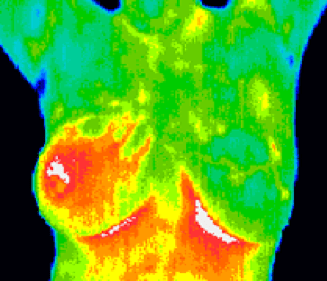Breast Thermography
Thermography is a painless, non-invasive, state of the art clinical test without any exposure to radiation and is used as part of an early detection screening program which gives women of all ages the opportunity to increase their chances of detecting breast disease at an early stage. It is particularly useful for women under a certain age where mammography is not indicated.
In 1982, the FDA approved Thermography as an adjunctive test to mammography. Thermography can be used in women of any age, or of any breast density. Breast development is usually complete by age 21, and therefore, it is probably a good time for a woman to begin screening for breast health with thermography. The benefit of breast thermography is that it offers the opportunity of earlier detection of breast disease than has been possible through breast self-examination, doctor examination or mammography alone.

THERMOGRAPHY’S ROLE IN BREAST CANCER AND OTHER BREAST DISORDERS IS TO HELP IN EARLY DETECTION AND MONITORING OF ABNORMAL PHYSIOLOGY AND THE ESTABLISHMENT OF RISK FACTORS FOR THE DEVELOPMENT OR EXISTENCE OF CANCER. WHEN USED WITH OTHER PROCEDURES THE BEST POSSIBLE EVALUATION OF BREAST HEALTH IS MADE.
THIS TEST IS DESIGNED TO IMPROVE CHANCES FOR DETECTING FAST-GROWING, ACTIVE TUMORS IN THE INTERVALS BETWEEN MAMMOGRAPHIC SCREENINGS OR WHEN MAMMOGRAPHY IS NOT INDICATED BY SCREENING GUIDELINES FOR WOMEN UNDER 50 YEARS OF AGE OR AS RECOMMENDED BY THEIR DOCTOR.
By performing thermography years before conventional mammography, a selected patient population at risk can be monitored more carefully, and then by accurately utilize mammography or ultrasound as soon as is possible to detect the actual lesion – (once it has grown large enough and dense enough to be seen on mammographic film), can increase the patients treatment options and ultimately improve the outcome.
It is in this role that thermography provides its most practical benefit to the general public and to the medical profession. It is certainly an adjunct to the appropriate usage of mammography and not a competitor. In fact, thermography has the ability to identify patients at the highest risk and actually increase the effective usage of mammographic imaging procedures.
Until such time as a cure has been found for this terrible disease, progress must be made in the fields of early detection and risk evaluation coupled with sound clinical decision making.
Thermography, with its non-radiation, non-contact and low-cost basis has been clearly demonstrated to be a valuable and safe early risk marker of breast pathology, and an excellent case management tool for the ongoing monitoring and treatment of breast disease when used under carefully controlled clinical protocols.
Canadian researchers recently found that infrared imaging of breast cancers could detect minute temperature variations related to blood flow and demonstrate abnormal patterns associated with the progression of tumors. These images or thermograms of the breast were positive for 83% of breast cancers compared to 61% for clinical breast examination alone and 84% for mammography.
Thermography can detect the subtle physiologic changes that accompany breast pathology, whether it is cancer, fibrocystic disease, an infection or a vascular disease. Your doctor can then plan accordingly and lay out a careful program to further diagnose and /or MONITOR you during and after any treatment.
All patients thermograms (breast images) are kept on record and form a baseline for all future routine evaluations. Each patient has a thermal fingerprint which will only change if pathology develops.

Normal Results
Good thermal symmetry with no suspicious vascular patterns or significant thermal findings.

Early Stage Malignant Tumor
This is the specific area of a small DCIS. We can see the vascular feed and the discreet area of hypothermia that is displacing the surrounding hyperthermia.

INFLAMMATORY BREAST CANCER
The results of this routine study led to the diagnosis of inflammatory carcinoma in the right breast. There were no clinical indications at this stage. (Thermography can show significant indicators several months before any of the clinical signs of inflammatory breast disease, skin discoloration, swelling and pain). Inflammatory breast disease cannot be detected by mammography and is most commonly seen in younger women, the prognosis is always poor. Early detection provides the best hope of survival.

Fibrocystic Changes
The very significant vascular activity in the left breast justified clinical correlation and close monitoring which returned an opinion of fibrocystic changes taking place. These changes can be monitored thermographically at regular intervals until a stable baseline is established and is reliable enough for annual comparison.

DUCTAL CARCINOMA IN SITU
This 37 year old patient presented for routine thermographic breast screening, she was not in a high risk category and had no family history. No breast exams had been performed previously. The vascular asymmetry in the upper left breast and the local hypothermia at 11 O’clock was particularly suspicious and subsequent clinical investigation indicated a palpable mass at the position indicated. A biopsy was performed and a DCIS of 2 cm was diagnosed. Unfortunately this patient only survived for 12 months after diagnosis.

Breast Cancer In Men
One per cent of breast cancers are found in men. The survival rate is much lower than in women as most breast cancers in men are only detected in advanced stages. This tumor was palpable at the time of imaging, there is a well established vascular feed which has even caused increased blood flow at the left brachial plexus and there is also drainage toward the sternum that extends to below the left breast.
“WITH THERMOGRAPHY AS YOUR REGULAR SCREENING TOOL, IT’S LIKELY THAT YOU WOULD HAVE THE OPPORTUNITY TO MAKE ADJUSTMENTS TO YOUR DIET, BELIEFS, AND LIFESTYLE TO TRANSFORM YOUR CELLS BEFORE THEY BECAME CANCEROUS. TALK ABOUT TRUE PREVENTION.”
— CHRISTIANE NORTHRUP, M.D.
LEARN MORE ABOUT THERMOGRAPHY

JOIN THE VISTA COMMUNITY
Subscribe to our newsletter to learn more about our latest events, get healthy recipes and information to help you live a healthy lifestyle.
